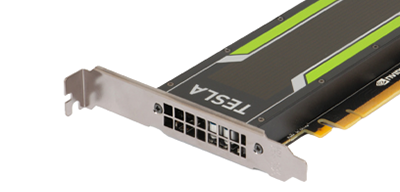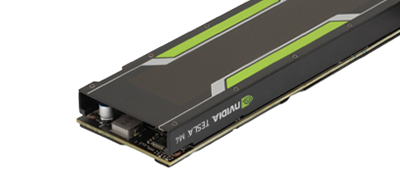NVIDIA Tesla M4 GPU Accelerator - System Overview
Description

The compact Tesla M4 is the first accelerator designed for hyperscale servers. It’s especially well-suited for dense hyperscale clusters of systems executing various machine learning workloads to help users keep up with the constant increase in data. The NVIDIA M4 GPU is a small low-powered card, but features 1024 CUDA cores and 4GB of memory. The card delivers features such as NVIDIA GPU Boost and Hyperscale Software Suite for applications that can benefit greatly from GPU acceleration in the data center.
Performance
The NVIDIA Tesla M4 graphics card offers multiple power configurations ranging from 50 to 75 watts of power. The low power consumption is a highlight in hyperscale data centers, especially for neural networks that recognize patterns and interpret data through clustering or labeling. This GPU is also outfitted with 1,024 NVIDIA CUDA cores, 64 texture mapping units, and 32 ROPs. It supports 2.2 TFLOPS of single precision performance (FP32) and 67 TFLOPS of double precision performance (FP64) performance.
Memory
NVIDIA has paired 4GB of GDDR5 memory, along with a 128-bit bus interface, with an 88GB per second memory bandwidth running at 1375 MHz. The Tesla M4 operates at a frequency of 872 MHz, which can be boosted up to 1072 MHz. GPU Boost manages the dynamic clock speed adjustment, which tracks a variety of data and allows real-time adjustments multiple times per second to speeds and voltages, optimizing performance in many applications.
Features

With a low-profile form factor, the Tesla M4 is the smallest and first Maxwell card that features the full GM206 GPU core. The accelerator supports NVIDIA GPU Boost and Hyperscale Software Suite to increase the card’s capabilities. If there’s extra power available, the clock speed increases until it hits a predetermined power target. The clock speed adjustment is controlled by GPU Boost, which monitors data and makes real-time changes to speeds and voltages several times per second, maximizing performance in each and every application. There are several features supported by Hyperscale Software Suite including: GPU Rest Engine for real-time accelerated services, GPU-accelerated FFMPEG for optimizing video processing, Image Compute Engine for powerful and dynamic image resizing, and GPU Inference Engine for modern deep learning workloads. Tesla cards are not able to produce images on a display because they are computational accelerators and do not have any display connectivity. Instead, the M4 GPU is connected to the system using a PCIe 3.0 x16 interface.
Summary
The NVIDIA Tesla M4 GPU Accelerator is based on the NVIDIA Maxwell architecture and has several features to accelerate workloads within the data center. 4GB of GDDR5 memory and low power consumption makes this GPU a great option to provide a powerful foundation for deep learning and video workloads. The low-profile single slot card is designed to increase application throughput, while reducing costs by half compared to its predecessor. And also offers 7 times more power-efficient processing for deep learning, machine learning prediction, and video workloads.
Check Availability



